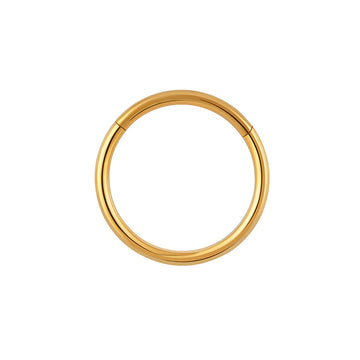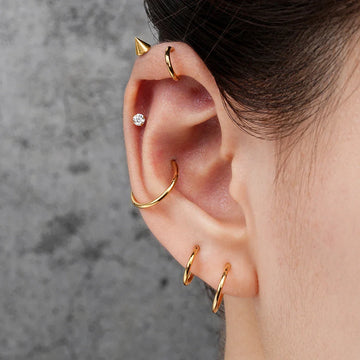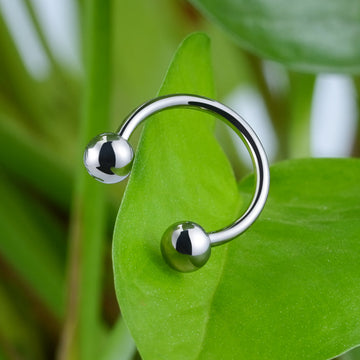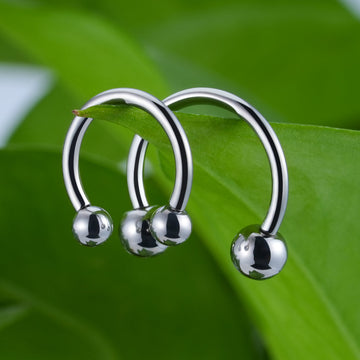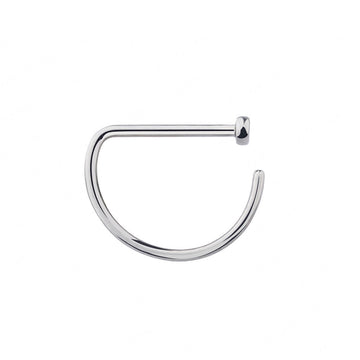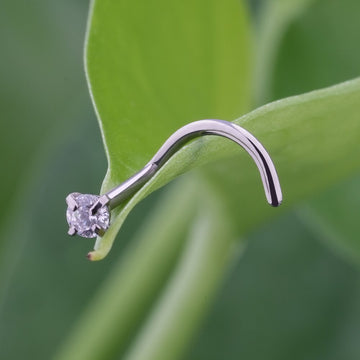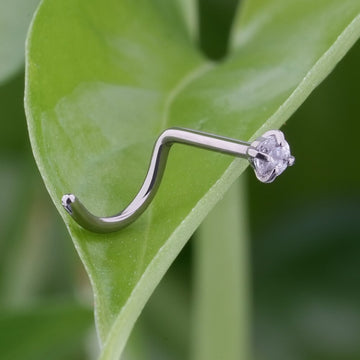What Is a Bridge Piercing? Costs, Healing, Pain, Jewelry, Sizes, Aftercare...
Sep 30, 2024
Fast Facts:
- Placement: At the bridge of the nose.
- Cost: $30-$60.
- Pain: 7/10 on the pain scale.
- Healing time: 4-6 months.
- Jewelry: The most common types are straight barbells and chains. Curved barbells (banana barbells) are also available.
- Risks: Rejections, scars, infections
Bridge piercings are a fun and unique way to express your individuality. Before scheduling an appointment with your piercer, it's important to understand whether you're a good candidate for one and what the aftercare process is like.
What Is a Bridge Piercing?
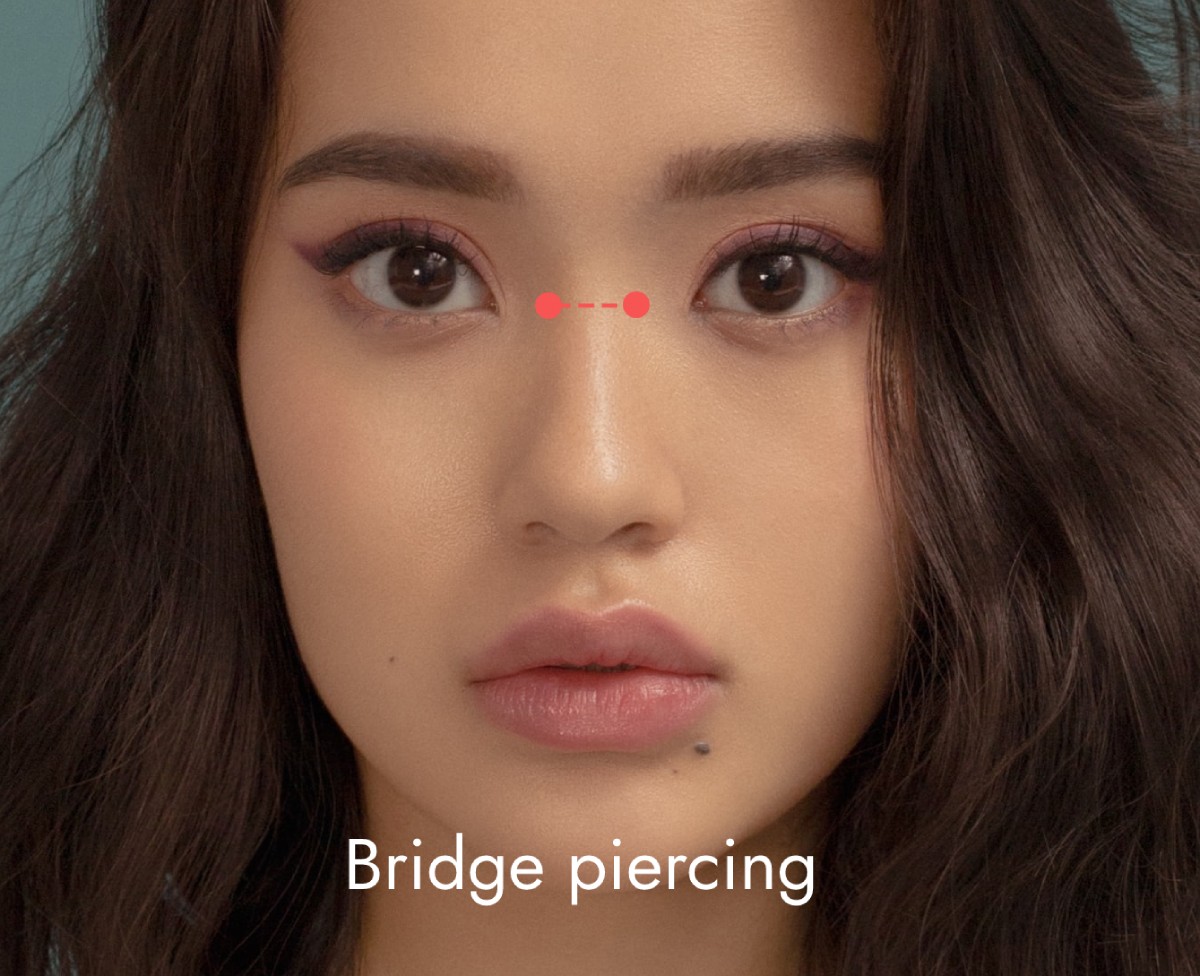
A Bridge piercing is a body piercing that lies horizontally across the soft tissue at the bridge of your nose. It is also sometimes referred to as an Earl or an Erl piercing.
Bridge piercings are surface piercings, which are not typically considered permanent. They can be challenging to heal and face a higher risk of rejection, migration, and other issues.
The most common types of Bridge piercing jewelry are straight barbells and chains. Curved barbells (banana barbells) are also available.
Variant: Vertical Bridge Piercing or Third Eye Piercing
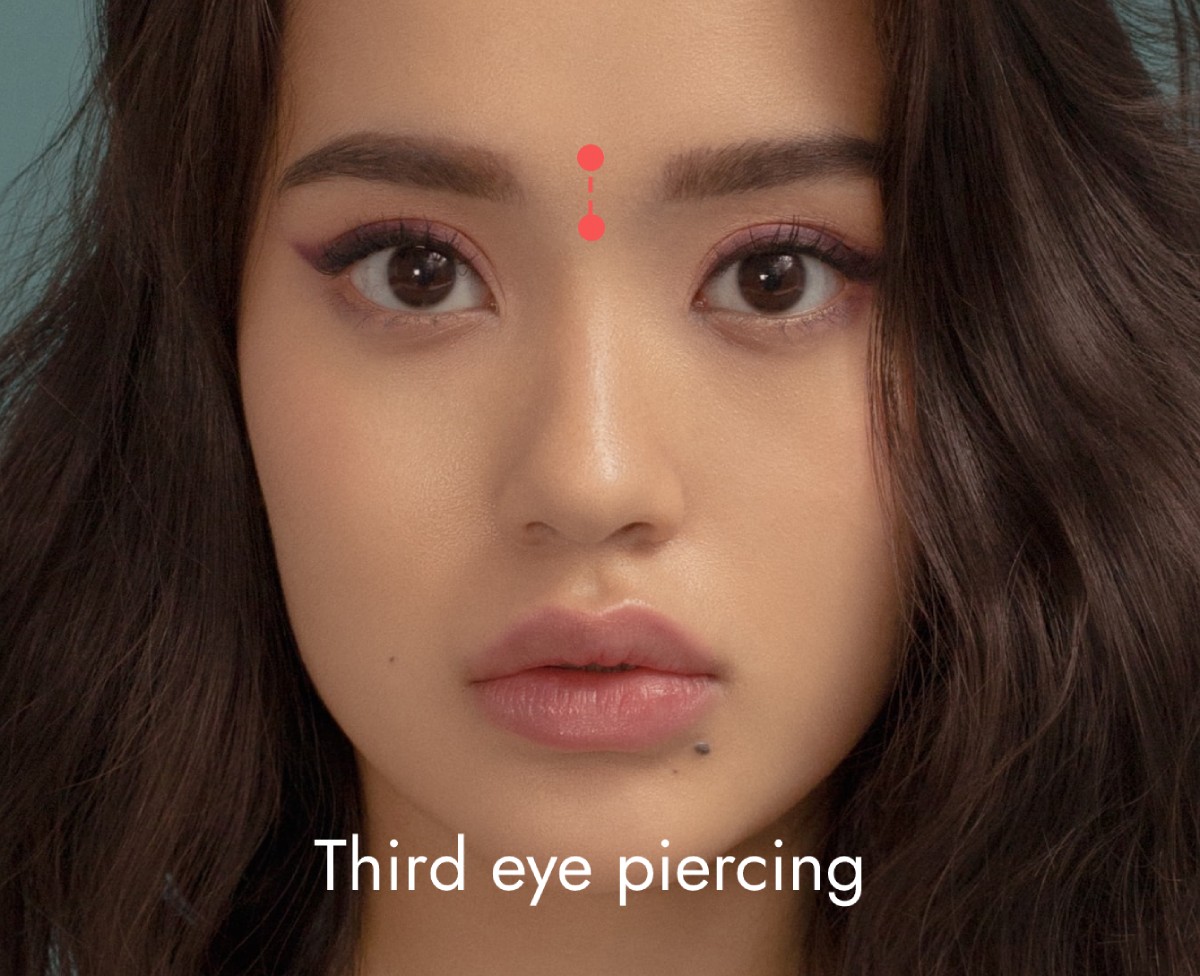
The vertical Bridge piercing is also called the Third Eye piercing or a "forehead piercing." But since the piercing is technically placed at the bridge of the nose, we'll include it here.
Variant: The Spiral Bridge Piercing
A spiral Bridge piercing is the same as a regular nose Bridge piercing, but using spiral-shaped jewelry creates a unique look.
To wear spiral Bridge piercing jewelry, you begin by inserting one end of the jewelry into one side of the Bridge piercing and slowly twist the piece into place.
What Is Special About This Piercing?
Bridge piercings are not just another body piercing option. They are a unique and bold choice that can make a powerful statement through your appearance. Their distinctiveness is a creative way to enhance features like your eyes or nose.
They are also relatively rare and can help you stand apart from the crowd.
However, Bridge piercings are surface piercings, which are not typically considered permanent. They can be challenging to heal and face a higher risk of rejection, migration and other issues.
Bridge Piercing Cost
How much is a Bridge piercing? A Bridge piercing typically costs between $30 to $60, depending on the studio, location, and piercer's experience.
Additional costs may include jewelry and aftercare products. It's important to choose a reputable piercer for safety and quality.
Bridge Piercing Pain Scale 1-10
While every piercing may cause some discomfort, the pain associated with a Bridge piercing is moderate yet generally manageable at a 7 out of 10.
It's normal to experience some bruising and swelling for a few days after getting pierced, but this can be comfortably managed with over-the-counter pain medication.
Bridge Piercing Healing Time
How long does a bridge piercing take to heal? Bridge piercings can take longer than other types of piercings to heal because of the amount of soft tissue they go through. You can expect your piercing to heal within 4 to 6 months, but it may take longer.
Like all piercings, the healing time of a Bridge piercing is influenced by how well you adhere to aftercare instructions and if complications occur.
Bridge Piercing With Glasses?
Can you get a Bridge piercing with glasses? Yes, you can wear a Bridge piercing with glasses. Just ensure your piercing is high enough on your nose so as not to interfere with them.
Consider bringing them along with you to your appointment so your piercer can ensure proper placement.
If you wear glasses or frequently wear sunglasses, make sure you discuss that with your piercer. They can help make sure that your piercing placement won't interfere with your frames.
Is a Bridge Piercing a Surface Piercing? Why?
Yes, the Bridge piercing is considered a surface piercing. A surface piercing is a piercing that lies flat against the skin just through the surface of the tissue. A Bridge piercing goes through the skin on the bridge of your nose. Therefore, it is considered a surface piercing.
Because the bridge of the nose is not very fleshy, it is not suitable for a dermal-style piercing.
Are Bridge Piercings Permanent?
Bridge piercings are surface piercings, which are not typically considered permanent. They can be challenging to heal and face a higher risk of rejection, migration, and other issues.
Although many people can wear a Bridge piercing for years, they often face complications that eventually cause them to remove the jewelry.
Do Bridge Piercings Always Reject?
Bridge piercings are not always rejected but have a much higher chance of doing so than other piercings. Some reasons Bridge piercings are rejected include the thinness of the skin along the bridge, constant movement, and wearing the wrong type of jewelry.
Will a Bridge Piercing Bump Go Away?
Piercing bumps are a common side effect with all piercings and may occur for various reasons, including poor aftercare, trauma, irritation, and snags. There are three types of piercing bumps that may form over time:
- Pustules - Pimple-like bumps that appear on or next to the piercing.
- Irritation bumps - Rash-like bumps that form due to friction.
- Hypertrophic scarring - A raised scar that forms as an abnormal response to wound healing.
Piercing bumps due to irritation or pustules will eventually go away with appropriate care. While hypertrophic scars can improve in appearance, they usually don't completely disappear. If you notice a piercing bump forming near your Bridge piercing, contact your piercer.
Bridge Piercing Sizes
1. What Gauge Is a Bridge Piercing?
The most common gauges for Bridge nose piercings are 12G (2 mm) and 14G (1.6 mm). Piercers often use a slightly larger needle to make healing easier and minimize the risk of rejection, as this is a rejection-prone area.
The larger hole allows for some swelling and prevents the healing from getting too tight as it heals. In addition, 16G (1.2mm) and 18G (1.0mm) don’t offer enough stability for a Bridge piercing.
That being said, the gauge of your nose bridge piercing is determined by your piercer since every person differs in the amount of tissue they have available. To minimize the potential for rejection, it is best to go with a larger gauge.
2. Bridge Piercing Length (inch and mm)
The length of your Bridge piercing jewelry should be between 1/2" (12 mm) and 5/8" (16 mm), depending on your anatomy.
These sizes promote healing and prevent the obstruction of your line of sight. If you notice the ends of your jewelry out of the corners of your eyes, it is likely too long.
Substantial swelling is not common with Bridge piercings, so it is unnecessary to start with jewelry that is extra long. Your best bet is to choose jewelry that already fits well since you cannot change it out for at least a couple of months as it heals.
Bridge Piercing Jewelry
Among all nose jewelry types, straight barbells are the common choice for this piercing type. However, shorter, curved barbells are also relatively common. These piercings make it look as though you have a small bead on either side of the bridge of your nose.
Hoops are not suitable for Bridge piercings because they are not generally wide enough in diameter to span the entire nose.
1. Straight Barbells

Piercing barbell internally threaded $18.9, SHOP NOW.
Straight barbells have a straight post with beads at each end. They can be internally or externally threaded and are most commonly worn in Bridge, tongue, eyebrow, Industrial, and nipple piercings.
2. Nose Bridge Chain Piercing

Double nose piercing chain titanium $17.9, SHOP NOW.
Chains can be an eye-catching embellishment to nose piercings. Nose chains will connect each end of a Bridge piercing across the bridge of the nose.
3. Curved Barbells (Banana Barbells)
Like straight barbells, this option features beads at each end but is slightly bent. It is appropriate for various piercings, including vertical labrets, eyebrow, and navel piercings.
4. Fake Bridge Piercing
You can also go with a fake Bridge piercing if you want to avoid the pain and risks of nose piercings.
Safe Metals for Bridge Nose Piercings
1. Titanium: About $20-$40

Piercing barbell with natural gemstones titanium $23.9, SHOP NOW.
Titanium has a reputation for being the best metal for piercings for many reasons. It is lightweight, hypoallergenic, durable, non-corrosive, and won’t tarnish.
Its non-porous nature reduces places bacteria can hide, promoting healing.
Titanium is hypoallergenic, meaning it is less likely to cause allergic reactions. Titanium is nickel-free. Its high density-to-strength ratio means your jewelry is very durable. A lower density also makes titanium lightweight, a big plus in many user's eyes. Finally, the metal comes in many colors because you can anodize it.
The only real downside to titanium jewelry is that you will pay more for all those positive traits. Shop for implant-grade titanium with designations like ASTM F-136, ASTM F-67, or ISO 5832-3.
2. Solid Gold: About $40-$200
This metal will not rust or tarnish. It is also easy to decorate and shape. The added alloys in 18k, and especially 14k, make them more durable than 24k gold pieces.
One downside to gold jewelry is the price tag, which is expensive. Another concern will be that the metal is soft, making it susceptible to bends, breaks, and gouges. Gold can also be heavy, especially with more pure karat ratings.
3. Surgical Steel: About $5-$30
Even surgical-grade steel contains small amounts of nickel that could cause allergic reactions in those with skin sensitivities. Choose a different option if you are concerned about irritation or a nickel allergy.
Steel combines iron and carbon, improving its strength and ability to resist fracturing.
One of the pros most people cite for steel jewelry pieces is the lower price point. Steel is also a durable option. These pieces are low maintenance because the steel does not corrode, rust, or tarnish.
Weight is the top complaint for those using steel jewelry pieces. Steel can be less comfortable if worn in piercings for long periods.
Potential Risks
All piercings come with risks, and some may face more complications than others. Some of the most common risks associated with this piercing style include:
1. Bridge Piercing Rejection and Migration
Rejections are highly possible due to their proximity to the skin's surface. Because the skin along the nose's bridge is thin and in constant movement, the jewelry may shift around quite a bit, increasing your risk of migration.
Signs that your skin is rejecting the piercing include:
- The jewelry is visible beneath the skin
- The eyebrow jewelry moves too freely than it should
- The piercing hole appears to be larger than usual
If you want to have an easy healing time after a bridge nose piercing, avoid playing, rotating, touching, or changing the jewelry. Wait until the wound is completely healed.
Hence, it is always advisable to go to a professional for any body art. It takes about 2-3 months for the piercing to heal fully, after which you can change your jewelry or add more piercings if you wish.
2. Bridge Piercing Scar
If you remove your piercing, there is a chance it will leave noticeable scars behind. If the piercing is removed early or becomes infected, the likelihood of scarring increases.
However, with proper healing and care, the scar may be minimal or fade significantly over time. Some people may not scar at all, while others may develop more noticeable marks.
Pros and Cons
All piercings have their fair share of pros and cons, and Bridge piercings are no different. Some of the reasons why people get a Bridge piercing include:
- It's a uniquely edgy yet modern look.
- It isn't as painful to get as some other types of piercings
- Despite their placement, they can be subtle depending on the jewelry you choose
However, there are several drawbacks to keep in mind when deciding whether to get a Bridge piercing:
- Bridge piercings have a higher rejection rate than other piercings.
- The healing process can be lengthier, especially if complications arise.
- Bridge piercings are temporary, although some people may wear their jewelry for years without issue.
Before getting a nose Bridge piercing, you should fully understand the risks associated with surface piercings and whether you are okay with a lengthy healing time.
While Bridge piercings are associated with a higher chance of complications, they offer a unique look and are a fun way to express your individuality.
How to Hide a Bridge Nose Piercing?
You can choose a piercing retainer. This is an unobtrusive (and often clear) piece that you can place through the piercing. That way, when you don't want to wear Bridge piercing jewelry, you won't run the risk of your piercing closing up.
That being said, when you first get your bridge pierced, it's important to not move it for 6-8 weeks. Once this initial healing period is over, you can then hide the piercing when needed.
How to Clean a Bridge Piercing?
It is recommended to use sterile saline that you buy from the store, rather than homemade saline, for cleaning your piercings. Homemade saline may be too salty for delicate piercing sites, leading to dryness and delayed healing.
Using mild, fragrance-free soap and water to clean your piercing site is also an option.
If you prefer homemade salt solution. You can start by mixing 1/2 teaspoon of non-iodized salt with one cup of distilled or boiled (for at least 20 minutes) water. You may choose to use less of the salt mixture like 1/4 to 1/8 teaspoon if you want a weaker solution that’s less likely to burn or sting. Stir the solution until it dissolves.
If you see signs of infection, you can also use antiseptic solutions, such as betadine, isopropyl alcohol, or diluted hydrogen peroxide. However, avoid using them for daily cleaning as they can damage cells.
Then proceed with the following steps to clean your piercing:
- Soak a cotton ball, a paper towel, or a non-plush cloth with the solution. Avoid fabrics that could snag and pull the jewelry or leave fibers behind. Gently saturate the piercing and cleanse it. Don't remove the jewelry!
- If you have a sterile saline wound wash that you buy from stores, then spay it while healing.
- Ensure you cleanse the piercing of any discharge or crusty material.
- Take clean gauze or cotton swabs and pat the area dry.
Your piercer should give you detailed instructions on how to keep your piercing clean once it has been placed.
Bridge Piercing Aftercare
- Be gentle when blowing your nose. Blowing your nose too hard can irritate the piercing site and slow down the healing process. Be gentle when blowing your nose, and avoid using tissues or other materials that may get caught on the jewelry.
- Take care to avoid contaminating the piercing.
- Avoid touching it or applying makeup very close to it.
- Avoid getting in the water that might be dirty.
- Clean your piercing twice per day using a saline solution made for wound cleaning or soap and water to prevent infection.
- Avoid ointments as they prevent necessary air circulation.
- And of course, make sure to avoid snagging on clothes or towels.
- Wear loose clothing. Avoid wearing tight clothing or clothing that may rub against the piercing, as this can cause irritation and slow down the healing process.
- Use hypoallergenic jewelry like implant-grade titanium and 14- or 18-karat gold. Surgical-grade steel may contain small amounts of nickel that could cause allergic reactions.
- Don't move the piercing unless you're cleaning it. Pulling on a piercing early in healing is painful, but it also can get in the way of healing or damage the piercing itself.
- Wait until your piercing heals before changing out your jewelry.
- Watch for potential signs of infection and consult your piercer or doctor if it becomes infected.
You should ensure you get pierced by someone experienced and reliable who utilizes the right cleaning and sterilization procedures. You’ll also need to choose high-quality jewelry that you aren’t allergic to. After you get your piercing, be sure to follow all instructions from your piercer.
Read More
9 Most Common Types of Nose Rings, Studs and Chains With Pictures













